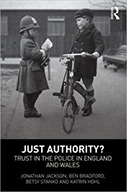Just Authority? Trust in the Police in England and Wales
 Authors: Jonathan Jackson, Ben Bradford, Betsy Stanko, and Katrin Hohl
Authors: Jonathan Jackson, Ben Bradford, Betsy Stanko, and Katrin Hohl
Publisher: London; New York: Routledge, 2012. 244p.
Reviewers: Elise Sargeant and Lorraine Mazerolle | September 2013
The book, Just Authority? Trust in the Police in England and Wales, is a comprehensive and timely exploration of public perceptions of police in London. As the authors note, the book was compiled amidst numerous high-profile challenges to police authority across the UK in the summer of 2011: in July, Sir Paul Stephenson, Police Commissioner of the Metropolitan Police, resigned under a cloud of criticism for hiring former News of the World executive, Neil Wallis, whom the police were investigating as part of the widespread phone-hacking scandal. Just one month later, England erupted in what became known as the “Blackberry riots” (Technology and disorder, 2011), triggered after police used deadly force against Mark Duggan during a traffic stop incident.
At the heart of the book is a desire to unpack, understand and analyse variations across different communities in the way people view the police. Why is it that the event on August 6 organized to protest against the police shooting of Mark Duggan turned into full blown riots in Tottenham, Birmingham, Peckham, Clapham and elsewhere in England, yet other places – such as Poplar in East London and Firth Park in Sheffield – remained unaffected? (Morrell et al., 2011, p. 10). Jackson and his colleagues bring to the fore the view that citizen attitudes to police vary within and across different types of communities. Drawing together two of the biggest theoretical areas of criminological scholarship in the last two decades – neighborhood processes and police legitimacy – Jackson and his colleagues use extensive survey data, sophisticated analysis and theoretical insight to understand citizen views of “just authority” and to place these views in the context of neighborhoods.
“Policing by consent” is the starting point and theoretical foundation of the book. As Charles Reith (1956, p. 140) in his New Study of Police History attests, “policing by consent … [is a philosophy of policing]….unique in history and throughout the world because it derived not from fear but almost exclusively from public co-operation with the police, induced by them designedly by behaviour which secures and maintains for them the approval, respect and affection of the public.” For Jackson and his colleagues, it is the empirical exploration and understanding of the neighborhood context of this classic, Peelian, “policing by consent” concept that distinguishes this book from earlier tomes on this common theme. Jackson and his colleagues tackle big, theoretical questions. They draw from psychology, criminology and sociology to test Tom Tyler’s (e.g. Sunshine & Tyler, 2003; Tyler, 2004; Tyler & Fagan, 2008) model of legitimacy and cooperation with police (in the UK context), extend definitions of legitimacy, uncover the “social ecology of trust, legitimacy and cooperation” (Jackson et al., 2013, p. 8), and examine perceptions of police in an ethnically diverse society.
To answer these and other questions, the authors draw on an array of complimentary data sources. These include 25 years of data collected in the British Crime Survey (BCS) (capturing trends in attitudes to, and experiences with, police over time), a media analysis of the portrayal of police in the news media over time, and the Metropolitan Police Service Public Attitudes Survey (METPAS) (providing data collected from individuals within neighborhoods) and an accompanying Black and Minority Ethnic (BME) booster sample (BME males aged 16–30 in four areas of London). These data offer a unique chance to explore perceptions of police in London over time, the effect of media on trends in confidence in the police, perceptions of police within the neighborhood context, and ethnic minority experiences with police in an ethnically diverse context (i.e. the UK).
In Part 2 the authors begin their empirical contribution with an analysis of trends and trajectories of confidence in (and contact with) police over 25 years. Using the British Crime Survey data from 1984 to 2005/06, Jackson and colleagues (2013, p. 21) identify a “convergence – not divergence – of levels of confidence in the police across key sociological variables”. They suggest that the demographic characteristics we traditionally associate with perceptions of police (i.e. age, gender, class and ethnicity) are becoming lesser predictors of confidence in the police over time (Jackson et al., 2013, p. 21). The authors attribute these changes to “late modernity” (Jackson et al., 2013, p. 30). Factors such as globalisation, greater equality of men and women in the workplace and the fading out of the class-system in the UK may mean that some demographic characteristics are less likely to define experiences and perceptions (Jackson et al., 2013, p. 30). While acknowledging that factors such as “identity”, “culture” and, of course, contact with police remain relevant, the authors highlight the lessening importance of who one is in explaining attitudes toward the police (Jackson et al., 2013, p. 31).
This introduction acknowledges the centrality of contextual factors, discussed later in the book. As the authors state: “If these characteristics are only weakly correlated with opinions of the police, we should look elsewhere for sources of variation in public trust” (Jackson et al., 2013, p.45). It is their explicating of the “contextual factors” that might address this quandary that is, in our view, the highlight of the book. Exploring the neighborhood context, or what Jackson and colleagues (2013, p. 14) call “the social ecology”, of trust, legitimacy and cooperation is an important advance in the development of police legitimacy theory. Prior research has examined attitudes to police in the neighborhood context; however, this research has mostly been conducted in the US and has only recently begun to explore the process-based model of legitimacy in the context of the neighborhood (see for example Gau et al., 2012). Jackson and his colleagues provide a comprehensive test of how the neighborhood and neighborhood characteristics can help to explain trust in police, police legitimacy and cooperation with police.
Just Authority? also advances our understanding of the complex processes that facilitate the capacity of police to “police by consent”. This theme is variously explored in Parts 3, 4, and 5. Jackson and colleagues’ previous analyses of the BCS in particular, highlight the value of refining the way in which perceptions of police are measured in research. In their previous publications, the authors have noted the inadequacies of single-item measures of trust and confidence in police (see, for example, Jackson & Bradford, 2010). Expanding on the way in which perceptions of police are measured has thus become a key feature of the body of work amassed by the authors over the past decade. In this book, Jackson and colleagues therefore seek to expand upon Tom Tyler’s model of procedural justice, trust in police and police legitimacy, by placing emphasis on not only the obligation to obey police, but also on the importance of moral alignment with the police (see Jackson, et al., 2013, pp. 12–14 for a detailed discussion). Moreover, their treatment of trust and legitimacy as distinct stories within the book represents a shift in thinking, as these concepts are often used interchangeably in prior research.
Expanding definitions of trust and legitimacy are indeed meaningful contributions to police research. In response to increasing scholastic critique of the measurement of police legitimacy (e.g. Reisig et al., 2007), Jackson and his colleagues return to early theoretical perspectives around trust and legitimacy and provide a thorough treatment of this issue. Of note, they seek to expand on Tyler’s model, rather than to replace this pivotal theoretical work. Drawing on theory and utilizing the METPAS data, in Parts 3 and 4 Jackson and his colleagues reconsider the meaning of “trust” and “legitimacy”. Regarding trust, they propose a three-pronged model: trust in police fairness, trust in “intentions and shared interests”, and trust in police effectiveness (Jackson et al., 2013, p. 69). Their definition of legitimacy also incorporates three elements: the tried and tested obligation to obey police, as well as the additional elements of moral alignment and legality. They find support for these models using both the METPAS and the BME samples. However, they do identify differences in the way in which young ethnic males perceive the police, in comparison to the general population of London. For example, they find that trust in police is comprised of two factors for the METPAS (trust in shared interests/procedural fairness and trust in police effectiveness) and four factors for the BME (trust in shared interests, trust in police effectiveness, trust in police fairness, and trust in procedural fairness) (Jackson et al., 2013, pp. 68–78). Comparing and contrasting these two samples is an important contribution to our understanding of police legitimacy and trust in police. Unfortunately, there are some slight differences in the measurement of perceptions of police across the two samples (for example, only one question was incorporated in the BME to measure moral alignment, while there was a more reliable scale of three items in the METPAS). Ideally, to provide a more robust comparison, the two surveys should have incorporated identical measures of police legitimacy. (Jackson et al., 2013, pp. 153–160).
After defining the key concepts of trust and legitimacy, the authors seek to determine the antecedents of trust and legitimacy, and later, cooperation with police (Part 5). A number of factors are considered, including police representation in the media, experiences with the police, ethnicity, and the context of neighborhoods. While the content analysis of the mass media is impressive and illuminating, and the treatment of ethnicity is thorough (i.e. they move beyond a Black vs. White understanding of ethnicity), what is most striking about these chapters (Parts 3, 4, and 5) is the use of sophisticated multi-level modelling techniques (including small area estimation) to situate the experience of policing within the context of the neighborhood, even though their “average cluster size of eight respondents” (Jackson et al., 2013, p. 24) is much fewer than the number of respondents per community or neighborhood recommended to generate stable and reliable ecometric estimates in, for example, the Chicago PHDCN study (see Raudenbush & Sampson 1999) or the Australian Community Capacity Study (see Mazerolle et al., 2012; Wickes et al., 2011).
Positioning experiences with, and perceptions of, the police within the neighborhood is not a new concept – indeed many scholars have noted the potential impact of neighborhood characteristics on the likelihood of having negative contact with the police and of being dissatisfied with police (e.g. Kane, 2005; Reisig & Parks, 2000). However, Jackson and his colleagues are among the first to examine whether and why perceptions of trust and legitimacy, and cooperation with police might vary across communities. Of note, they find that a significant proportion of the variation in trust in police, police legitimacy, and the willingness to cooperate with police can be attributed to the neighborhood in which an individual resides. This finding alone points to the need for a greater consideration of the ecology of perceptions of police. Importantly, their findings support Tyler’s model of police legitimacy – and their expansion of these concepts – even when accounting for the context of the neighborhood. While the authors draw on US research to support their findings about why neighborhood context is important, the book could have benefited from greater extrapolation around the differences between the neighborhood context of the UK compared to other countries (for example police legitimacy, legal cynicism and perceptions of police have been examined in the US and in Trinidad and Tobago see, for example, Sampson & Jeglum-Bartusch, 1998; Kochel, 2012). For example, in Chapter 12, greater consideration could have been given to comparing and contrasting the UK and US neighborhood contexts. In this regard, the authors found a positive relationship between police legitimacy and disadvantage; however, US research generally supports a negative relationship between disadvantage and satisfaction with police and a positive relationship between disadvantage and legal cynicism. Future, comparative research could explore these findings in more detail.
In Part 6, the authors conclude by grounding the theoretical concepts they explore firmly in reality. While the sometimes esoteric nature of trust and legitimacy may not immediately appeal to those who suggest real-world policing is about fighting crime, Jackson and his colleagues put critics in their place. After all, without fairness, how can police “secure long-term commitment to institutions and the rule of law”? (Jackson et al., 2013, p. 216). They suggest that treating citizens with fairness and respect does not replace the use of policing strategies such as stop-and-search (which may undermine legitimacy); rather, trust and legitimacy are accoutrements that the police can deploy to achieve the outcomes they desire. A more hard-line approach might be to suggest that spending too much time focusing on customer service might detract from the ability of police to prevent and control crime – this is clearly a direction that future research can explore.
In this review, we present what are arguably the highlights of an engaging and a thorough examination of perceptions of police legitimacy in the UK context. We expect that the book will hold particular appeal not only for policing scholars, but also for those interested in the ecology of social behavior. Just Authority is a discerning and well written tome that will also appeal to police practitioners in the UK and beyond – the chapters are short and sharp, and the authors provide clear explanations of their results that will speak not only to theoreticians, but also to practitioners.
References
Gau, J. M., Corsaro, N., Stewart, E. A., & Brunson, R. K. (2012). Examining macro-level impacts on procedural justice and police legitimacy. Journal of Criminal Justice, 40(4), 333–343. doi: 10.1016/j.jcrimjus.2012.05.002
Jackson, J., & Bradford, B. (2010). What is trust and confidence in the police? Policing, 4(3), 241–248. doi: 10.1093/police/paq020
Jackson, J., Bradford, B., Stanko, B., & Hohl, K. (2013). Just Authority? Trust in the police in England and Wales. Abingdon, UK: Routledge.Kane, R. J. (2005). Compromised police legitimacy as a predictor of violent crime in structurally disadvantaged communities. Criminology, 43(2), 469–498.
Kochel, T. R. (2012). Can police legitimacy promote collective efficacy? Justice Quarterly, 29(3), 384–419.
Mazerolle, L., Wickes, R., Cherney, A., Murphy, K., Sargeant, E., & Zahnow, R. (2012) Community variations in crime: A spatial and ecometric analysis Wave 3. Brisbane, Australia: ARC Centre of Excellence in Policing and Security.
Morrell, G., Scott, S., McNeish, D., & Webster, S. (2011). The August riots in England: Understanding the involvement of young people. London, UK: National Centre for Social Research (NatCen).
Raudenbush, S. W., & Sampson, R. J. (1999). Ecometrics: Toward a science of assessing ecological settings, with application to the systemic social observation of neighborhoods. Sociological Methodology, 29, 1–41.
Reisig, M. D., Bratton, J., & Gertz, M. G. (2007). The construct validity and refinement of process-based policing measures. Criminal Justice and Behavior, 34(8), 1005–1028.
Reisig, M. D., & Parks, R. B. (2000). Experience, quality of life and neighborhood context: A hierarchical analysis of satisfaction with police. Justice Quarterly, 17(3), 607–630.
Reith, C. (1956). New study of police history. London, UK: Oliver and Boyd.
Sampson, R. J., & Jeglum Bartush, D. (1998). Legal cynicism and (subcultural?) tolerance of deviance: The neighborhood context of racial differences. Law & Society Review, 32(4), 777–804.
Sunshine, J., & Tyler, T. R. (2003). The role of procedural justice and legitimacy in shaping public support for policing. Law & Society Review, 37(3), 513–548.
Technology and disorder: The BlackBerry riots (2011, August 13). The Economist. Retrieved from http://www.economist.com/node/21525976
Tyler, T. R. (2004). Enhancing police legitimacy. The ANNALS of the American Academy of Political and Social Science, 593(1), 84–99.
Tyler, T. R., & Fagan, J. (2008). Legitimacy and cooperation: Why do people help the police fight crime in their communities? Ohio State Journal of Criminal Law, 6, 231–276.
Wickes, R., Homel, R., McBroom, J. Sargeant, E., and Zahnow, R. (2011). Community variations in crime: A spatial and ecometric analysis Wave 2. Brisbane, Australia: ARC Centre of Excellence in Policing and Security:.
Lorraine Mazerolle is a Research Professor in the Institute for Social Science Research (ISSR) at the University of Queensland and an Australian Research Council (ARC) Laureate Fellow.
Dr. Elise Sargeant is a research fellow at the Institute for Social Science Research (ISSR) and an Associate Investigator in the Australian Research Council (ARC) Centre of Excellence in Policing and Security (CEPS).


